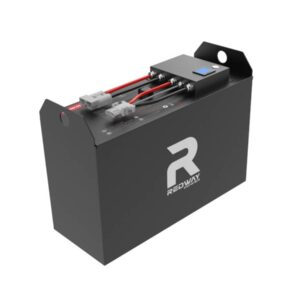What is the 80 20 rule for batteries?
The 80-20 rule for batteries advises maintaining charge levels between 20% and 80% to optimize lithium-ion lifespan. Avoiding full 100% charges and deep discharges below 20% reduces electrode stress, minimizing capacity fade. This partial state-of-charge (PSoC) strategy balances usable energy and longevity, often doubling cycle counts compared to full-depth cycles.
Optimal Forklift Battery Installation and Maintenance
What defines the 80-20 rule for batteries?
The 80-20 rule is a lithium-ion management practice limiting charge/discharge to 20%-80% capacity. By avoiding voltage extremes—like 4.2V/cell (100%) or 2.5V/cell (0%)—it reduces cathode lattice strain and electrolyte oxidation, key drivers of aging. Think of it as keeping batteries in their “comfort zone” for sustained health.

Technically, lithium-ion degradation accelerates outside 3.0V–4.1V/cell thresholds. For a 48V LiFePO4 pack (16 cells), this translates to 51.2V (80%) and 44.8V (20%). Pro Tip: Use smart chargers with adjustable voltage cutoffs—many EVs allow setting 80% max charge via their BMS. For example, a Tesla Model 3 in “Daily Use” mode follows 80-20 principles, retaining 90% capacity after 100,000 miles versus 70% with full cycles. But what if you need maximum range occasionally? Occasional 100% charges are acceptable but avoid letting the battery sit at full voltage for hours.
| 80-20 Usage | Full 0-100% Cycles |
|---|---|
| 1,200–2,000 cycles | 500–800 cycles |
| ~80% capacity retention at 1,000 cycles | ~60% retention at 500 cycles |
Why is the 80-20 rule critical for lithium-ion longevity?
Lithium plating and SEI growth dominate battery decay. At full charge, excessive lithium ions embed in anodes, causing metallic plating that permanently reduces capacity. Below 20%, cathode over-discharge triggers structural cracks. The 80-20 rule minimizes both risks.
Practically speaking, a 100Ah battery cycled between 20Ah–80Ah delivers 60Ah usable energy per cycle. While this sacrifices 40% capacity upfront, it extends total lifetime energy by 3x. Pro Tip: For solar storage systems, set inverters to 80% charge during sunny days—depth of discharge (DoD) management prevents night-time dips below 20%. For example, a Powerwall cycled daily at 80-20 retains 85% capacity after 10 years versus 60% with full cycles. But how do temperature extremes affect this? Heat amplifies degradation above 80%, while cold worsens discharge stress below 20%.
How to implement the 80-20 rule effectively?
Use programmable chargers and BMS adjustments to enforce voltage limits. Many EVs, e-bikes, and solar controllers have software options to cap charging at 80-90%. For DIY setups, select chargers with ±0.5% voltage accuracy.
Beyond basic settings, consider adaptive charging. Some systems like Tesla’s “Trip Mode” temporarily allow 100% charges before long drives but revert to 80% afterward. Pro Tip: Pair 80-20 practices with moderate discharge rates—keeping currents below 0.5C reduces heat buildup. For example, a 200Ah golf cart battery discharging at 100A (0.5C) within 20-80% sustains 1,500 cycles, versus 800 cycles at 1C. What about lead-acid batteries? The 80-20 rule isn’t ideal—they prefer full cycles to prevent sulfation. Lithium’s chemistry uniquely benefits from partial cycles.
| Battery Type | Optimal DoD |
|---|---|
| LiFePO4 | 20-80% |
| NMC | 10-90% |
| Lead-Acid | 50-100% |
Battery Expert Insight
FAQs
Does the 80-20 rule apply to all lithium batteries?
Mostly. LiFePO4 benefits most due to its flat voltage curve, while NMC tolerates 10-90% ranges. Always check manufacturer specs—some high-performance cells are optimized for deeper discharges.
Can I occasionally charge to 100% without harming the battery?
Yes—infrequent full charges (e.g., monthly) have negligible impact. Just avoid prolonged storage at 100%. Rebalance cells after full cycles to correct voltage drift.
